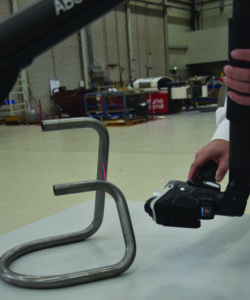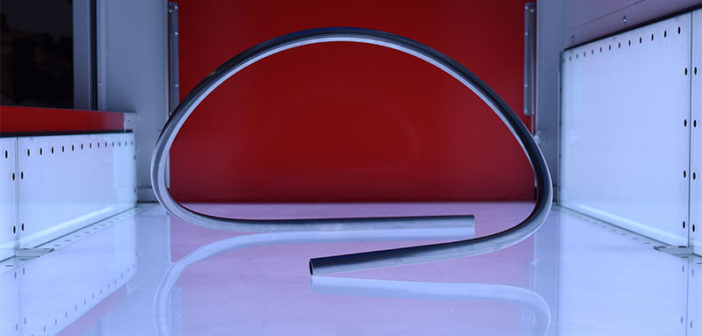While it’s not always at the forefront of people’s minds, bent tubing plays a prominent role in products across a wide range of industries. From automotive components to furniture pieces, bent tubes made from a wide array of materials are all around us. And all that tubing requires a lot of bending machines.
According to a recent report, the global bending machine market is expected to record a compound annual growth rate of 4.97 percent through 2022. This is great news for bending machine manufacturers such as Dynobend, located in Haaksbergen, the Netherlands.
Dynobend is an internationally operating bending machine manufacturer and bending specialist that has been using Hexagon products to ensure the quality of its parts and machines since 2016. I recently had the chance to sit down for a conversation with Mr Ben Siemerink, Mechanical Engineer at Dynobend, to find out more about the challenges Dynobend face in the modern bending machine market and their experiences in adding Hexagon tools to their workflows.
Mr Günter Suilmann [GS]: Can you tell us a little about Dynobend?
Mr Ben Siemerink [BS]: We make bending machines and are a specialist when it comes to bending. We have customers around the world using our portfolio of high-quality bending systems, including some custom solutions and other bent-tube-production related products. We’ve been offering bending solutions for the bending of tubes and profiles in almost every possible branch for almost 30 years now – I think if it’s possible to bend it, we can handle it.
Particularly important for us is the capability to handle truly freeform bending. Freeform tubes are used in multiple industry segments, such as architecture, furniture production and more. It’s an expanding part of the industry, butit requires a high-level of technical skill.
GS: A lot of suppliers speak about freeform bending, but in the end they bend standard tubes with regular bend-in-bend geometries. What makes Dynobend different?
BS: At Dynobend, we can offer real freeform bending solutions. This means that we’re able to continuously change the radii and rotation at any position along the tube.
GS: Dynobend has been working in the field of freeform bending for many years. What would you say is unique today compared to solutions Dynobend offered in the past?
BS: Perhaps most important is that the solutions we can offer today are not anymore influenced by operator skill. With previous solutions, we could never really guarantee that each correction loop was really an improvement in terms of the quality of the tube geometry, which meant that the setup of new parts was not fully predictable. As part of our new software platform we were able to implement new algorithms, and now operator interaction is no longer required to guarantee a successful programming of our machine. Our current solution is now also applicable to the production of tubes consisting of both freeform and standing geometries.
GS: Since 2016, Dynobend has been using the TubeInspect optical tube measurement system. What made you make that investment?
BS: Yes, we’ve been using a TubeInspect P16 in our plant since 2016. The reason we decided to invest in a TubeInspect was to support our R&D projects in the development of a dedicated product line for freeform bending. To support this development, we needed a measuring system that continuously provides repeatable and accurate results that are not influenced by an operator. TubeInspect fit those requirements perfectly.
GS: How is the workflow for production of a freeform tube?
BS: Today we can offer customers a very comfortable workflow. At the beginning of any freeform bending process, we start with the CAD-file in IGES format, which includes the centre line of the 3D tube. Based on this file, the programming of our machine is quite simple: we load up the file in our Dynobend FreeformManager software and automatically generate the production programme for the bending machine, taking into account pre-specified individual material and tooling behaviours.
If the first part produced is not perfect, we then use the TubeInspect unit to make the fine adjustments needed. In this case we first measure the tube, and the BendingStudio software calculates a smooth point cloud that defines the centre line of the measured tube that we can use to calculate correction parameters for our machine through our Dynobend Tube Optimizer software. Depending on the material behaviours, usually only two or three correction loops are required before we have the right settings for our machine.
GS: Since 2018, Hexagon has also offered beside the TubeInspect machine a solution using the Absolute Arm with BendingStudio. What was your experience when testing this new solution?
BS: The new Absolute Arm with BendingStudio solution greatly extends the range of possible applications of BendingStudio within tube production. While TubeInspect is today limited in its measuring volume, only being able to handle tubes up to 2.5 metres in length, the Absolute Arm can capture data from much longer tubes. In addition, the Absolute Arm offers great portability, allowing us to move the system around the workshop to wherever it’s needed. And as both systems are running with the same software, full compatibility with our Dynobend solution is always guaranteed.
Bending machine technology has become increasingly accessible and usable over the past two decades, even prompting many companies to invest in their own in-house bending machines rather than sourcing tubing from a third party. And as this market continues to grow, quality control processes become more and more important, especially for bending machine manufacturers that need to make sure they deliver simple yet accurate bending solutions to customers that often aren’t bending specialists.
It’s clear that Dynobend recognise this importance. They’ve had the foresight to appreciate how valuable accurate quality control can be in the field of tube bending and beyond that in the field of bending machine manufacturing. Their experience has shown this to be particularly true when it comes to the development of more challenging processes such as true freeform bending.
Our TubeInspect and Absolute Arm with BendingStudio solutions offer clear benefits for such a forward-thinking business, and we only look forward to working more with Dynobend over the coming years as they continue to develop their range of innovative solutions for the tube bending industry.














